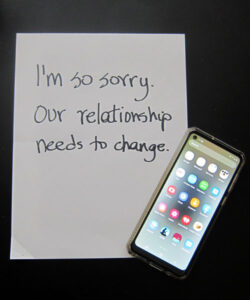In last week’s post, I talked about how and why our brains are wired for distraction and interruption. That facility keeps us alert to threats when our attention is focused on other matters. It works wonders in primitive environments that are rife with peril but doesn’t serve us terribly well in our twenty-first century technology-laden lives.
 According to statistica.com, 85% of American adults owned Smartphones as of February 2021. Half claim to use them 5-6 hours per day; another 22% copped to 3-4 hours of daily usage. It’s hardly surprising. They’re key communications devices (calls, email, text) with integrated cameras, Internet access, and a mind-boggling warehouse of downloadable apps. Author Catherine Price acknowledges their utility but explores their deleterious effects in her 2018 book How to Break Up with Your Phone. In particular:
According to statistica.com, 85% of American adults owned Smartphones as of February 2021. Half claim to use them 5-6 hours per day; another 22% copped to 3-4 hours of daily usage. It’s hardly surprising. They’re key communications devices (calls, email, text) with integrated cameras, Internet access, and a mind-boggling warehouse of downloadable apps. Author Catherine Price acknowledges their utility but explores their deleterious effects in her 2018 book How to Break Up with Your Phone. In particular:
- They feed our thirst for novelty with an everchanging media stream (and get us addicted to it).
- With an array of configurable alerts and easy access to the associated apps, they’re designed to get us to use them. Every time we hear a “ding,” our distractible brains note the intrusion; curiosity (and Fear of Missing Out) compels our attention. We lose our train of thought on the task at hand and become far less efficient completing it.
- A sustained pattern of distraction overloads working memory. We don’t process incoming data and register it effectively across multiple schema in long term memory. This deficiency inhibits our capacity for creativity and complex thought.
- They stimulate the pleasure sensors in our brains. We tune in to see if there something good to consume or to relieve boredom or anxiety. Once they’ve captured our attention, they provide no cues to get us to stop. We just numb out.
- They provide the illusion of human connection through social media and give us the means to be “liked.” Yet studies have shown that the more we use social media, the less happy we are. We get caught up comparing ourselves to others and fixated on who is (or is not) paying attention to us. We’re also subject to context-specific gleaned from our browser history.
- The blue light radiating from Smartphones inhibits sleep by delaying the proper release of melatonin. And to the extent that we encounter something unpleasant during these late-night episodes, we may ruminate on it long past lights out.
In short, despite all their utility, Smartphones can have a negative impact on physical, cognitive, and emotional health. A bit of restraint may improve our lives without impinging on all the great things these devices can do. Here are some suggestions:
- Pay attention to the habit loops that feed phone addiction. Do your reach for it as soon as you get out of bed? Do you take action whenever you hear an alert? Do you mindless surf the phone while watching TV? Then ask yourself: What’s driving the behavior? Habit? Anxiety? Boredom? Is there a healthier response?
- Turn off alerts on all but essential applications. Customize the latter to minimize unwanted disruptions.
- Schedule times for uninterrupted work; turn off the phone and leave it in another room. Enroll family, friends, and colleagues in respecting your privacy during this time.
- Make it more difficult to check social media by getting rid of the custom apps on the phone. Use the Internet browser for access with the associated inconvenience of logging in. If that seems too extreme, set an alarm on the phone when connecting to apps to limit time spent there.
- Resist the temptation to look at the phone first thing in the morning or within an hour of bedtime. There are plenty of other hours in the day to plug in!
Feeling the need for a more structured intervention? Grab a copy of Catherine’s book and follow her “30-day plan to take back your life.”